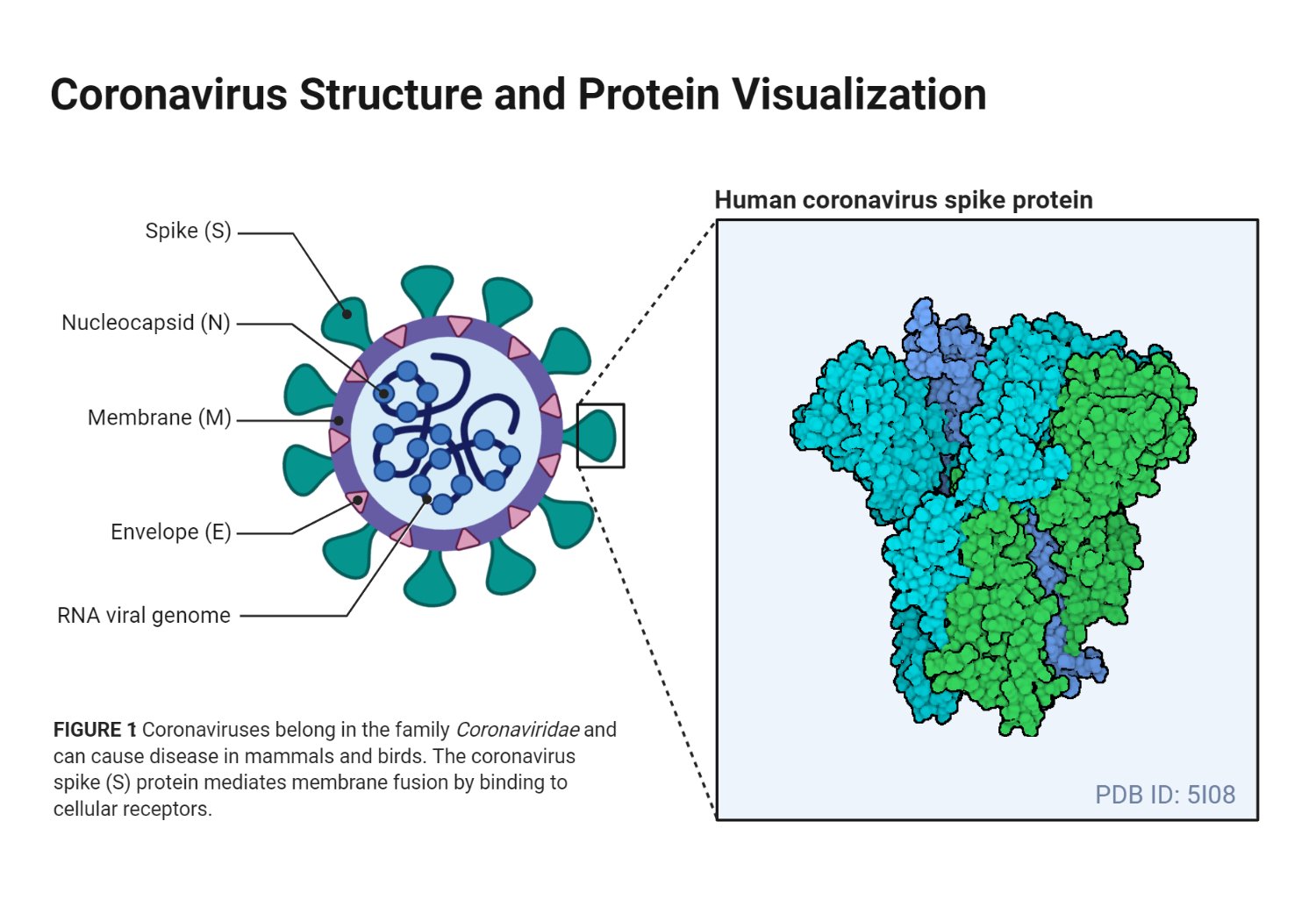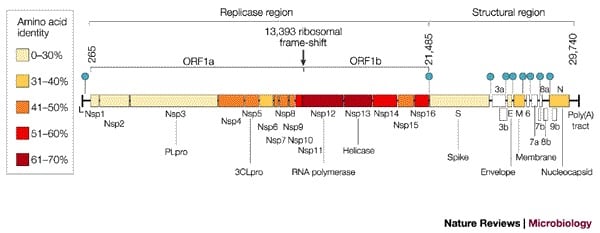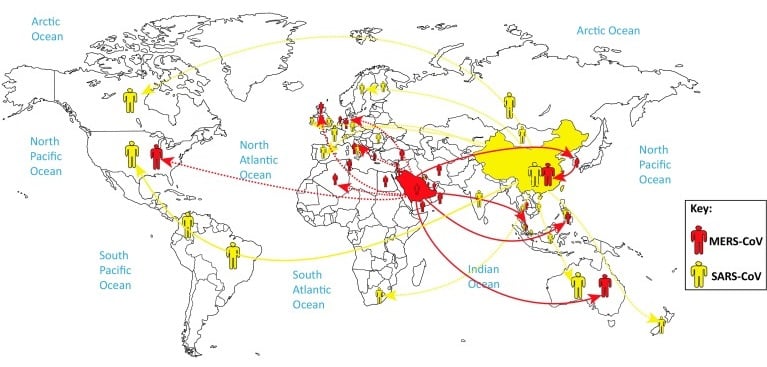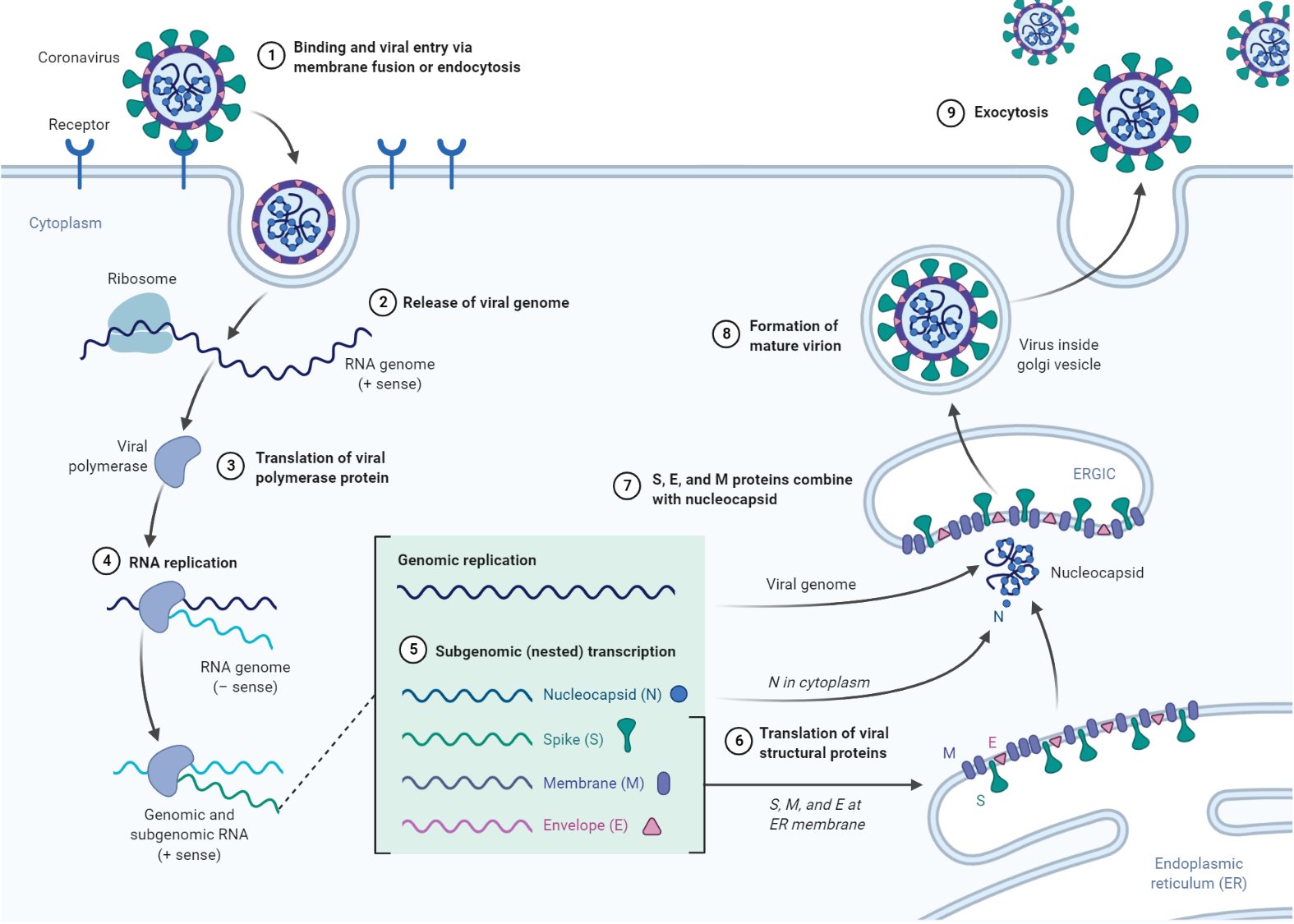Interesting Science Videos
Structure of Coronavirus
- Coronaviruses fall in the virus family Coronaviridae, order Nidovirales.
- Coronaviruses are enveloped, 120 to 160 nm particles that contain an unsegmented genome of single-stranded positive-sense RNA (27–32 kb).
- The large, plus-stranded RNA genome associates with the N protein to form a helical nucleocapsid.
- The helical nucleocapsid is 9–11 nm in diameter.
- There are 20 nm long club or petal-shaped projections that are widely spaced on the outer surface of the envelope, suggestive of a solar corona.
- The viral structural proteins include a 50–60 kDa phosphorylated nucleocapsid (N) protein, a 20–35 kDa membrane (M) glycoprotein that serves as a matrix protein embedded in the envelope lipid bilayer and interacting with the nucleocapsid, and the spike (S) a 180–220 kDa glycoprotein that makes up the petal-shaped peplomers.
- Some viruses, including human coronavirus OC43 (HCoV-OC43), contain a third glycoprotein (HE; 65 kDa) that causes hemagglutination and has acetylesterase activity.

Figure: Structure of Coronavirus, created with biorender.com
Genome of Coronavirus

- Coronavirus genomes are monopartite, single-stranded, positive-sense, polyadenylated, and capped RNAs ranging from 27 to 32 kb in length.
- The 5′ approximately 20 to 22 kb carries the replicase gene, which encodes multiple enzymatic activities.
- The replicase gene products are encoded within two very large open reading frames, ORFs 1a and 1b.
- The order of the genes encoding the viral RNA-dependent RNA polymerase and the four common structural proteins, the spike (S), envelope (E), membrane (M), and nucleocapsid (N) proteins are indicated as Pol-S-E-M-N.
- Coronavirus genomes also include a variety of additional open reading frames (ORFs) that encode two to four nonstructural proteins of unknown functions.
- In the genome, a common intergenic sequence (IS) of about 7 bases is found at the 5′ end of each gene.
- This IS sequence is essential for the formation of subgenomic RNAs.
- Coronavirus-infected cells contain multiple overlapping subgenomic, capped, and polyadenylated mRNAs with a common 3′ end.
- Each subgenomic mRNA and the viral genomic RNA, which also serves as an mRNA, is translated to yield only the protein encoded by the 5′ gene on the mRNA.
Epidemiology of Coronavirus

- Natural outbreaks of colds caused by coronaviruses occur predominantly during the winter months, although in children, two peaks in late autumn to early winter and early summer were detected.
- It is estimated that coronaviruses cause 15–30% of all colds.
- Studies using virus detection or serology have shown that HCoV 229E, OC43, and NL63 occur worldwide.
- The contribution of each HCoV may vary widely from year to year, for example, 229E contributing as little as 1% to acute respiratory infections in the community in one year and up to 35% in the next.
- The incidence of coronavirus infections varies markedly from year to year, ranging in one 3-year study from 1% to 35%.
Replication of Coronavirus

Figure: Replication of Coronavirus, created with biorender.com
- Natural infection of humans with human respiratory coronaviruses occurs through exposure to respiratory secretions.
- Coronaviruses attach to their glycoprotein receptors on host cells via their S proteins.
- Viral entry is mediated by fusion of the viral envelope with the host cell membrane or by receptor-mediated endocytosis.
- Group 1 coronaviruses 229E and NL63 bind to the metalloproteases, human aminopeptidase N and angiotensin-converting enzyme 2 (ACE-2) respectively.
- The receptors for OC43 and HKU-1 have not been yet identified.
- The fusion of the viral and cell membranes (either at the cell surface or within the endocytic vesicle) is mediated by the S2 portion of the virus spike protein which functions as a class 1 fusion protein.
- Once the viral RNA is released into the cytoplasm, translation of the positive-strand genomic RNA gives rise to a large polyprotein that undergoes proteolytic processing to generate an RNA-dependent RNA polymerase.
- An RNA-dependent RNA polymerase translated from the plus-stranded viral genomic RNA makes a negative-strand that serves as the template for a nested set of five to seven subgenomic mRNAs.
- Translation of subgenomic mRNAs gives rise to structural viral proteins.
- The N protein and newly synthesized genomic RNA assemble to form helical nucleocapsids.
- Membrane glycoprotein M is inserted in the endoplasmic reticulum (ER) and anchored in the Golgi apparatus.
- The nucleocapsid (N plus genomic RNA) binds to M protein at the budding compartment (ERGIC).
- E and M proteins interact to trigger the budding of virions, enclosing the nucleocapsid.
- These newly formed virions are transported via the Golgi apparatus to the plasma membrane where they are released by exocytosis.
Pathogenesis of Coronavirus
- The primary route of transmission of human coronaviruses is via the respiratory tract, most likely spread by aerosols and in large droplets (e.g., sneezes).
- Infection with the common-cold coronaviruses leads to loss of ciliary action (ciliostasis) and degenerative changes affecting the cilia of epithelial cells of the respiratory tract.
- Infection remains localized to the upper respiratory tract because the optimum temperature for viral growth is 33° C to 35° C and may lead to the lower respiratory tract.
- HCoV-OC43 is generally associated with mild upper respiratory tract infections, although it has been shown to have neuroinvasive properties.
Clinical manifestations of Coronavirus
- HCoVs in both the 229E- and OC43-related serogroups cause upper respiratory signs and symptoms in adults and children that vary in frequency and severity.
- HCoVs cause respiratory infections(bronchiolitis and pneumonia), but gastroenteritis and neurological disorders can also occur.
- The human coronaviruses produce “common colds,” usually afebrile, in adults.
- The symptoms include nasal discharge and malaise.
- Other symptoms include rhinorrhea, headache, malaise, chills, sore throat, and cough.
- The incubation period is from 2 to 5 days.
- Symptoms last for a mean of 7 days, with a range of 3 to 18 days.
- Patients with symptomatic coronavirus infection show a rise in neutralizing and complement fixation antibody titers in the serum after inoculation that waned after months.
- The lower respiratory tract is seldom involved, although pneumonia may occur.
- Asthmatic children may suffer wheezing attacks, and respiratory symptoms may be exacerbated in adults with chronic pulmonary disease.
- HCoV-OC43 can infect neurons and cause encephalitis.
Lab Diagnosis of Coronavirus
Specimen: respiratory secretions, stool (HKU1)
- Virus isolation- The human hepatoma cell-line HUH7 has been recently used for primary isolation of OC43, 229E and HKU-1 viruses from clinical specimens and NL63 has been isolated in LLC-MK2 and Vero B4 cells.
- Detection of viral RNA by RT-PCR.
- Electron microscopy of negatively stained stool specimens is useful for the detection of enteric coronaviruses.
- Complement fixation, ELISA assays, immunofluorescence or virus neutralization tests have been used for serological diagnosis.
- The serologic diagnosis of infections with strain 229E is possible using a passive hemagglutination test in which red cells coated with coronavirus antigen are agglutinated by antibody-containing sera.
- HCoV-OC43–related virions that express a HE glycoprotein on the viral envelope can also be detected by hemagglutination and acetyl esterase assays.
Treatment of Coronavirus
- There is no proven treatment for human coronavirus infections and no vaccine.
Prevention and control of Coronavirus
- Washing hands often with soap and water.
- Avoid touching eyes, nose, or mouth with unwashed hands.
- Avoiding close contact with people who are sick.
- Covering mouth and nose with a tissue while coughing or sneezing, then throw the tissue in the trash and washing hands.
References
- Jawetz, Melnick, & Adelberg’s Medical Microbiology, 28e
- David Greenwood, Medical Microbiology
- Topley and Wilson’s Microbiology and Microbial Infections, 8 Volume Set, 10th Edition
- Schaechter’s Mechanisms of Microbial Disease
- http://www.nejm.org/doi/full/10.1056/NEJMc1509458?rss=searchAndBrowse&#t=article
- http://www.asmscience.org/content/book/10.1128/9781555815790.ch20
Internet Sources
- 7% – https://www.sciencedirect.com/topics/pharmacology-toxicology-and-pharmaceutical-science/porcine-respiratory-coronavirus
- 2% – https://www.sinobiological.com/Coronavirus-Replication-a-6112.html
- 2% – https://www.sciencedirect.com/topics/medicine-and-dentistry/virus-detection
- 2% – https://www.nejm.org/doi/10.1056/NEJMc1509458
- 2% – https://www.ncbi.nlm.nih.gov/pmc/articles/PMC1306801/
- 2% – https://www.cdc.gov/coronavirus/about/prevention.html
- 2% – https://www.buttecounty.net/Portals/21/Diseases/Infectious/Pertussis09212015.pdf
- 2% – https://accessmedicine.mhmedical.com/content.aspx?sectionid=217775573
- 2% – http://intranet.tdmu.edu.ua/data/kafedra/internal/micbio/classes_stud/en/med/medprof/ptn/Microbiology,%20virology%20and%20immunology/2/11_Arboviruses_Adenoviruses_Herpesviruses.htm
- 1% – https://www.sciencedirect.com/topics/veterinary-science-and-veterinary-medicine/sars-coronavirus
- 1% – https://www.researchgate.net/publication/11091330_Methods_in_virus_diagnosis_Immunofluorescence_revisited
- 1% – https://quizlet.com/9128784/viral-infections-of-the-respiratory-tract-flash-cards/
- 1% – https://brainly.com/question/4675165
- <1% – https://www.thermofisher.com/uk/en/home/references/molecular-probes-the-handbook/probes-for-organelles/probes-for-the-endoplasmic-reticulum-and-golgi-apparatus.html
- <1% – https://www.sciencedirect.com/science/article/pii/S0168170214004948
- <1% – https://www.sciencedirect.com/science/article/pii/S0006349509004172
- <1% – https://www.researchgate.net/publication/304399321_Structural_basis_of_viral_RNA-dependent_RNA_polymerase_catalysis_and_translocation
- <1% – https://www.ncbi.nlm.nih.gov/pmc/articles/PMC267257/
- <1% – https://medworm.com/rss/medicalfeeds/source/Virus+Research.xml
- <1% – https://courses.lumenlearning.com/microbiology/chapter/agglutination-assays/
- <1% – http://research.lunenfeld.ca/bremner/files/file/SFV.pdf

good job and good information
https://youtu.be/pI86TCc1Sbc
What happens if we apply electric doses to the coronavirus
The most cogent presentation of Co-V that I have seen to date!
Kudos to the illustration team….Brilliance (an educational gem) in the complex world of cellular and molecular bio.
Thank you.
Es de mucha ayuda esta información.
Incluir sobre los estudios de elaboración de la vacuna y en cuanto tiempo estará al alcance de la población.
Así mismo, es muy importante dar a conocer datos estadísticos, y los métodos de contención utilizados y recomendados para disminuir la propagación.
Gracias
The following statistics should be added:
Total number of reported cases (+). Including China.
The data must include the date of the report and the age of the subject.
Also include separately cases of survivors and lethal.
And above all update it day by day.
If the above is not possible, there should be links where to consult the sources.
Good job!!!
– upgrable –